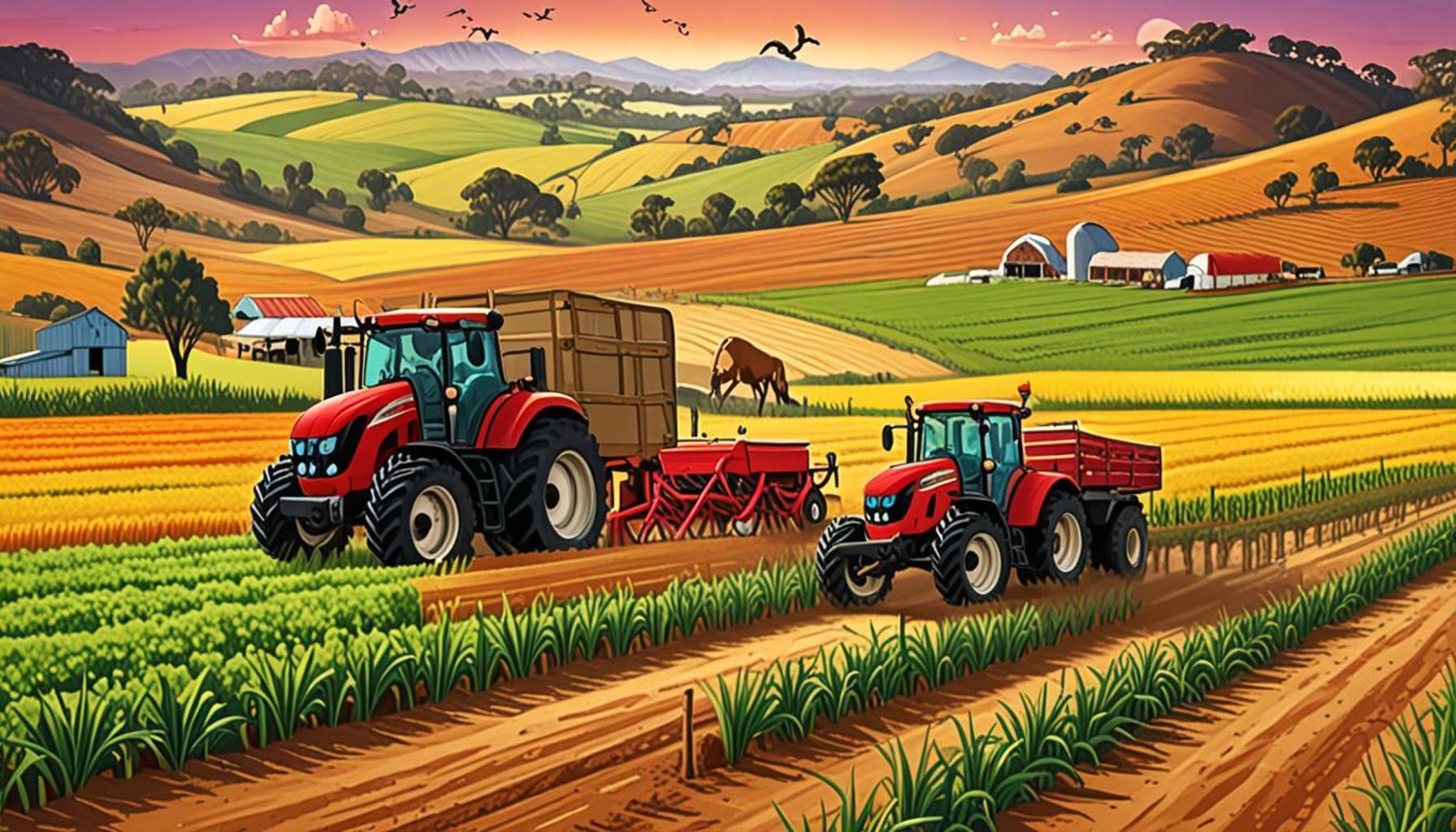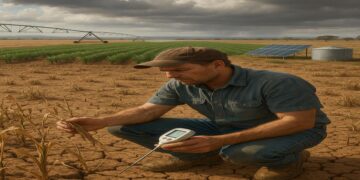Challenges of the Australian Agricultural Sector in Times of Globalization

The Importance of Understanding Agricultural Challenges
The agricultural sector is a cornerstone of Australia’s economy, contributing significantly to the country’s food supply, employment, and export revenues. With the dynamics of the global market continuously evolving, it has become crucial for local farmers and stakeholders to navigate the array of challenges that are arising. An in-depth understanding of these challenges is essential not only for the prosperity of farmers but also for maintaining the agricultural sector’s viability and food security in Australia.
Increased Competition
Increased competition from international markets poses a significant challenge for Australian farmers. Countries such as Brazil and India, which have lower production costs due to cheaper labor and land, can offer similar agricultural products at much lower prices. This trend is particularly evident in commodities like sugar and cereals, where Australian farmers find themselves struggling to compete. For example, the sugar industry in Queensland has faced pressure from imports, which has led to calls for government interventions to protect local producers.
Market Volatility
Another challenge affecting Australian agriculture is market volatility. Global events, such as trade disputes or unexpected weather patterns linked to climate change, can cause significant spikes or drops in market prices. For instance, a sudden drought in a key agricultural region can lead to diminished crop yields, which in turn raises prices for consumers and disrupts the supply chain. The unpredictable nature of these events can make it extremely difficult for farmers to plan operational or financial strategies, leading to increased uncertainty in their livelihoods.
Keeping Up with Technological Advancements
The rapid pace of technological advancements presents another layer of complexity. Innovations in agricultural techniques, such as precision farming, hydroponics, and genetically modified organisms (GMOs), can significantly enhance productivity and efficiency. However, small-scale farmers in Australia may find it difficult to adopt these new technologies due to high costs or inadequate training. As a result, they might miss out on opportunities to improve their operations, ultimately impacting their competitiveness in a global market that increasingly values innovation.
The Environmental Impact
Consumer trends are also shifting towards sustainability, imposing further demands on Australian agriculture. There is a growing expectation that farming practices should minimize environmental impact, such as reducing carbon emissions and promoting biodiversity. This shift requires farmers to innovate and adapt, which can entail significant investment in new practices or technologies. Additionally, the ongoing threats posed by climate change—including droughts, floods, and wildfires—add an element of unpredictability that can severely affect crop yields and livestock health.
Addressing these challenges is crucial not only for the agricultural sector’s sustainability but also for ensuring stable food security for Australia in the future. By expanding support systems, investing in research and development, and encouraging adaptive practices, stakeholders can help secure a thriving agricultural landscape for generations to come.
Understanding the Multifaceted Challenges Facing Australian Agriculture
The challenges confronting the Australian agricultural sector are multi-dimensional and complex, particularly when viewed through the lens of globalization. As the world becomes more interconnected, local farmers are not only competing with international players but are also grappling with evolving consumer expectations and environmental concerns. This section will explore some of the key challenges affecting Australian agriculture today and shed light on their implications for the industry.
Labor Shortages
Labor shortages have emerged as a pressing issue within the Australian agricultural landscape, impacting productivity and harvest outcomes. With many Australians moving to urban areas in search of employment opportunities, the pool of available farm workers has significantly diminished. This trend has been accentuated by the global pandemic, which limited the influx of seasonal workers, particularly from overseas. For example, crop farmers in regions like Victoria and New South Wales have reported significant losses due to an inability to source enough labor for tasks such as fruit-picking and planting.
Access to Markets
Another challenge faced by Australian farmers is access to markets. While globalization has opened new opportunities for exporting goods, it has also created barriers, particularly regarding compliance with international regulations and standards. Local farmers often need to navigate complex certification processes to sell their products abroad, which can be costly and time-consuming. For instance, Australian dairy producers aiming to export to countries with stringent health standards may encounter hurdles that are not present for competitors in less regulated markets. This adds pressure on farmers who must balance the costs of compliance with the need to remain competitive.
Environmental Sustainability
The demand for environmental sustainability is reshaping the agricultural sector. With consumers increasingly prioritizing sustainable practices, Australian farmers are compelled to adapt their methods to meet these expectations. However, transitioning to more eco-friendly practices, such as regenerative agriculture or organic farming, often involves significant investment and changes in land management. Farmers may need support in the form of education and financial assistance to navigate this shift effectively. As a result, sustainability becomes not only an ethical issue but also a matter of economic viability.
Trade Relationships and Tariffs
Australia’s trade relationships play a critical role in the agricultural sector’s success. Fluctuations in trade agreements and tariffs can directly impact profitability, with changes often stemming from geopolitical tensions or shifts in policy. Trade disputes, such as those seen recently between Australia and some Asian countries, can lead to retaliatory tariffs that make Australian exports less competitive in key markets. This not only affects income for farmers but also has repercussions throughout the supply chain, including processing and transport sectors.
- Labor shortages impacting productivity
- Access to international markets requiring compliance with regulations
- Environmental sustainability demanding innovative practices
- Trade relationships and tariffs affecting competitiveness
Understanding these challenges and their implications is vital for all stakeholders in the agricultural sector. By identifying the key areas needing attention, proactive measures can be taken to ensure the resilience and sustainability of Australian agriculture in the context of globalization.
The Impacts of Climate Change on Agricultural Practices
One of the most significant challenges facing the Australian agricultural sector is the impact of climate change. Australia is already one of the driest inhabited continents, and changing weather patterns are exacerbating issues such as drought and flooding. Farmers are increasingly finding it hard to predict weather conditions, which affects crop yield and livestock management. For instance, the 2019-2020 bushfire season severely impacted agricultural areas, leading to loss of livestock and decreased productivity. As climate patterns continue to change, farmers will face more frequent and severe weather events, necessitating the adoption of adaptive management strategies to mitigate risks.
Adoption of Technology
The adoption of technology within the agricultural sector presents both opportunities and challenges. Precision agriculture, which uses advanced technologies like drones and satellite imagery, can lead to increased efficiency and sustainable practices. However, many farmers, particularly in remote areas, struggle with access to the internet and reliable service to fully utilize these technologies. Additionally, the financial burden of investing in cutting-edge equipment can be a barrier for smaller operations. For example, a family-owned farm in Queensland may want to implement data analysis tools to enhance crop management, but the costs associated with such technology may limit their ability to compete with larger agribusinesses.
Competition from Global Markets
The growing competition from global markets poses another significant challenge. Australian farmers must contend with not only domestic competitors but also international producers who may have lower production costs due to favorable regulations, climate, or labor costs. For instance, when competing with beef producers from Brazil or Argentina, Australian cattle ranchers often find themselves facing price pressures that can make it difficult to maintain profitability. This situation can lead to a race to the bottom, where farmers compromise quality and sustainable practices to maintain market share, further impacting the overall integrity of Australian agriculture.
Consumer Perception and Health Trends
Changing consumer perception and health trends also affect the agricultural sector. With an increasing focus on health and diet, there has been a notable shift towards plant-based diets, which in turn has led to a decline in demand for certain meat and dairy products. Farmers must either adapt to these changing demands or risk losing their market presence. For example, a sheep farmer in Tasmania may find that traditional lamb product sales are declining, prompting them to explore alternative products, such as wool or even plant-based meat substitutes. This transition requires innovation and a willingness to experiment, which can be both a challenge and an opportunity.
- Climate change impacting yield and livestock management
- Technology adoption offering both opportunities and barriers
- Competition from global markets driving down prices
- Changing consumer perception altering demand for products
As Australian farmers navigate these complexities, a collaborative approach involving governmental support, innovation, and community engagement becomes essential for overcoming these challenges in the modern agricultural landscape.
Conclusion
In summary, the Australian agricultural sector faces a multitude of challenges in the context of globalization. The effects of climate change have become more pronounced, leading to unpredictable weather patterns that directly impact crop yields and livestock management. Farmers must adapt their practices to ensure sustainability and resilience against these environmental shifts. Additionally, while the adoption of technology holds promise for increased efficiency, the costs and accessibility of such advancements can hinder smaller farms from fully benefiting, creating a disparity in competitiveness.
Moreover, the pressure from global market competition forces Australian farmers to maintain high standards amidst lower-cost producers from other countries. This scenario threatens not only profitability but can also compromise quality standards in the rush to cut prices. Coupled with the evolving consumer perceptions that lean towards plant-based diets, the agricultural landscape is shifting rapidly, and farmers must be prepared to innovate to meet these new demands.
As we look forward, fostering collaboration between farmers, government entities, and community stakeholders will be paramount. By leveraging innovation, sharing resources, and understanding market trends, the Australian agricultural sector can navigate these challenges successfully. Embracing change with agility will enable our farmers to not only survive but thrive in an ever-evolving global marketplace. With the right strategies in place, there is potential for a bright future in sustainable agriculture that meets both local and international needs.

James Carter is a financial writer and advisor with expertise in economics, personal finance, and investment strategies. With years of experience helping individuals and businesses make complex financial decisions, James offers practical insight and analysis. His goal is to give readers the knowledge they need to achieve financial success.






